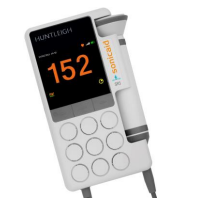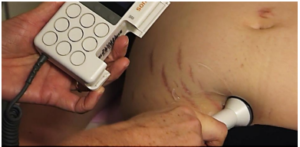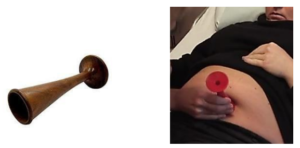Fetal Monitoring
On this page:
This information explains how we assess your baby’s heartbeat in pregnancy and labour. If you have any further questions, please speak to a midwife or doctor caring for you.
1. What is fetal monitoring and why is it offered?
Fetal monitoring is a way of assessing your baby’s wellbeing by monitoring their heartbeat. It does not predict birth outcomes but gives us a snapshot of how your baby is at that moment. Fetal monitoring might help detect changes in your baby’s normal heartbeat
pattern.
2. How do we listen to your baby’s heartbeat and when will you
have fetal monitoring?
There are different devices we can use to listen to your baby’s heartbeat; they are described below with photos of each device and explanations of how they are used in both pregnancy and in labour.
a) With a handheld doppler or a Pinard stethoscope
A handheld doppler (often called a Sonicaid) is a battery operated ultrasound device that is placed on your abdomen (stomach). You will then hear your baby’s heartbeat through the device’s speaker. It is waterproof and can be used in a birthing pool.
Please see the images below of a handheld doppler (left image) and where it may be placed on your abdomen (right image).


Images used with kind permission from Huntleigh Healthcare Ltd.
A Pinard stethoscope is a non-electrical device. One end is placed on your abdomen and the midwife will place their ear on the other end to hear your baby’s heartbeat. You will not hear anything yourself if a Pinard is used as only the midwife using the Pinard will be able to hear your baby’s heartbeat.
Please see the images below of a Pinard stethoscope (left image) and where it may be
placed on your abdomen (right image).

Using a handheld doppler or a Pinard stethoscope in pregnancy:
- We can listen to your baby’s heartbeat with a Pinard stethoscope or handheld doppler in your pregnancy from 16 weeks onwards.
- There is no national guidance recommending we do this at your routine midwife
appointments but your midwife may offer it to you. - When you are 16 weeks pregnant your baby is very small so it is normal for your
midwife to take a longer time to find your baby’s heartbeat. - If you attend Delivery Suite Triage (this is our assessment area in Delivery Suite),
the Day Assessment Unit or if you are admitted onto the Antenatal Ward and you are between 16 weeks to 25 weeks and 6 days pregnant, we will offer to listen to your baby’s heartbeat with a handheld doppler or Pinard stethoscope. - If you are pregnant with twins we will not offer to listen to your baby’s heartbeat with a handheld doppler or Pinard stethoscope in pregnancy due to the increased number of scans you have. Scans can assess the different heartbeats of twin 1 and twin 2 with greater accuracy.
Using a handheld doppler or a Pinard stethoscope in labour:
- In a low risk / uncomplicated labour a handheld doppler or Pinard stethoscope can be used to periodically listen to your baby’s heartbeat. This type of fetal monitoring is called intermittent auscultation but your midwife might refer to it as ‘listening in’.
- It is the recommended way to listen to your baby’s heartbeat if you are in labour
between 37 weeks – 41 weeks and 6 days pregnant and do not have any complications in your pregnancy or labour (NICE guideline [NG229], point 1.2.9,
published: 14 December 2022) - Intermittent auscultation allows free movement during labour as you are not attached to a monitor with cables.
- This type of monitoring can be carried out at a home birth, on Carmen Birth Centre or on Delivery Suite.
- Each time we listen to your baby’s heartbeat we will usually do so for one minute.
- In any stage of labour we will listen to your baby’s heartbeat immediately after a
contraction. Although this may seem an inconvenient time, it is the best time to
detect how your baby is coping with labour. - How often we listen to your baby’s heartbeat will change depending on your labour progress:
– In early labour (when your cervix is 0 – 5cm dilated), many people will stay at home during this time but if you are admitted into hospital our guidelines
recommend listening to baby’s heartbeat every four hours.
– In established labour (when your cervix is 5 – 10cm dilated) our guidelines
recommend listening to baby’s heartbeat every 15 minutes.
– If it’s confirmed that your cervix is 10cm (fully) dilated or we identify that you are starting to push your baby out, our guidelines recommend listening to your baby’s heartbeat every 5 minutes to monitor baby more closely as they move down the birth canal.
At St. George’s Hospital, we follow World Health Organization (2018) guidance that
established labour is from 5cm dilated.
b) A CTG with an abdominal monitor
A CTG is a continuous electronic recording of your baby’s heartbeat; its full name is a
cardiotocograph. It is a way of continuously monitoring your baby’s heartbeat and can last
between 20 minutes to several hours, depending on the circumstances. The most common way to carry out a CTG is by using an abdominal monitor. If you have fetal monitoring using an abdominal monitor you will hear your midwife or doctor refer to it as ‘having a CTG’ or they may ask if they can ‘put you on the monitor’.
When this monitoring is carried out, two plastic discs (known as transducers) are placed on your abdomen at the same time; they are both attached to a monitor by a cable. One of the transducers is an ultrasound device that is used for monitoring your baby’s heartbeat (if you are pregnant with twins we will use two of these to listen to both babies). The second transducer is a monitor that is sensitive to pressure which can show us if / how often you are having contractions. Both transducers are held in place using straps that fit around your abdomen.
The following images show where the transducers are placed on your abdomen (left image) and an example of the monitor to which the cables from the transducers are attached (right image). A slightly different monitor may be used depending on the circumstances.

Images used with kind permission from Huntleigh Healthcare Ltd.
Having a CTG in pregnancy:
- If you are over 26 weeks pregnant and you attend Delivery Suite Triage (this is our assessment area in Delivery Suite), the Day Assessment Unit or if you are admitted onto the Antenatal Ward with a complication it may be recommended to have a CTG.
- Examples of complications include (but are not limited to) your waters breaking / you have abdominal pain and you are less than 37 weeks pregnant; vaginal bleeding; reduced fetal movements (please see the additional resources section to access more information about reduced fetal movements and monitoring your baby’s movements).
Having a CTG In labour:
- If you have any complications in your pregnancy you may be advised to have a CTG in labour (NICE guideline [NG229], point 1.3, published: 14 December 2022).
- Our hospital guidelines also recommend a CTG in labour for everyone having an
induction of labour or an epidural. - This type of monitoring can only be performed on Delivery Suite.
- It is possible to adopt upright and active birthing positions when having a CTG in
labour and we actively encourage this. However, there are limitations to your ability to mobilise as the transducers on your abdomen have cables that are attached to a wall mounted monitor. You will still be able to stand, move off the bed and change position regularly but you may be asked to adopt certain positions to optimise the monitoring of your baby’s heart rate if there is difficulty with obtaining a clear signal. - We do have an option for a wireless abdominal monitor to be used. These are
transducers that do not have cables attached to them but unfortunately they are not available in every room in Delivery Suite. If this is something you are keen to use then please discuss with your midwife.
In labour a CTG can be carried out using an abdominal monitor (as described above), it can alternatively be carried out using a fetal scalp electrode (often called an FSE).
c) A CTG with an FSE
An FSE is a small spiral wire (that is less than 1mm thick) that is placed on your baby’s head; it is applied by a midwife or doctor during a vaginal examination. The small tip of the wire goes under the top layer of skin on your baby’s head in the area where your baby’s hair grows. It will stay in place during your labour, the wire will descend out of your vagina and plug into a port which is strapped to your leg. The port also has a cable attached to it which plugs into a wall mounted monitor. The port additionally has a small white circular sticker attached to it that is placed on the inside of your thigh (please see the photos below
for an example of how these may look).
If you have an FSE in labour, it will be used instead of the transducer on your abdomen that listens to your baby’s heartbeat. However, we will still use the other transducer on your abdomen that tells us if / how often you are having contractions.
These images show what the FSE wire looks like (left image), where it is placed on your
baby’s head (centre image) and where the port will be strapped to your leg (right image).

Images used with kind permission from Neoventa.
If your midwife or doctor recommends having a CTG in labour with an FSE they will have a discussion with you explaining the reasons why it is recommended. There may be circumstances where it is difficult to pick up your baby’s heartbeat with the abdominal monitor (because of your baby’s position, for example) and we might offer to monitor your baby with an FSE in this situation. An FSE will only be offered to you if you are in labour and your waters have broken.
If you are not in labour and you are having a CTG we will never use an FSE, we will always use an abdominal monitor. If you have monitoring with an FSE you will still hear your midwife or doctor refer to it as ‘having a CTG’.
An FSE allows you to move freely (within the proximity of the wall mounted monitor) in the birthing room as once it is applied it rarely needs to be repositioned. When the FSE is removed there is a low risk of minor bleeding from the site where the tip of the wire was applied to your baby’s head. There is also a low risk of a very small scar on your baby’s head however this would not be visible as your child grows. There is not an option to have a wireless FSE; with an FSE there will always be a cable between the port strapped to your leg and the wall mounted monitor.
d) STAN monitoring
If you have a CTG in labour with an FSE we can carry out an additional type of monitoring called STAN monitoring. The addition of STAN monitoring means that as well as monitoring your baby’s heartbeat, we can also take a regular ECG of your baby’s heart. An ECG is information about the rhythm, rate and electrical activity of your baby’s heart. This provides us with more detailed information about how your baby is coping with the potential stress of labour.
3. Additional information about fetal monitoring
An individualised risk assessment will be carried out by your midwife or doctor regarding the type of monitoring recommended for you. This risk assessment is a continual process and due to this, the advised method of fetal heart rate monitoring may change throughout the course of your labour.
Our recommendations regarding fetal monitoring are based on our hospital and national guidelines. If you make an informed decision to decline the recommended type of fetal monitoring it is important you have a discussion with a clinician during your pregnancy. You can ask your midwife at your antenatal appointments for a birth options referral to discuss your choices with a senior midwife or obstetrician.
If there are no identified risk factors for fetal compromise (such as induction, epidural or a more complex pregnancy) there is a risk of increased interventions if you have a CTG in labour compared with intermittent auscultation (NICE guideline [NG229], point 1.2.8, published: 14 December 2022).
4. Information about Induction of Labour for Post Dates
If you are having an induction of labour for post dates (this is when your pregnancy has
gone beyond 41 weeks) and wish to use Carmen Birth Centre, this may be possible if
certain criteria are met, however it is important you understand that:
- When you have an induction of labour, medication is commonly used as part of this process (please refer to the induction of labour patient leaflet for more information on this). National guidance states that the medication used for the induction process ‘can cause hyperstimulation – this is when the uterus contracts too frequently or contractions last too long, which can lead to changes in fetal heart rate and result in fetal compromise’ (NICE guideline [NG207], point 1.1.3, published: 04 November 2021).
- Due to this, our guidelines for induction of labour recommend birthing on Delivery Suite and having a CTG once in established labour (when your cervix is 5cm dilated) so that we can continually observe for any signs of hyperstimulation and/or changes in your baby’s heartbeat.
- On birth centre we carry out intermittent auscultation of your baby’s heartbeat using a handheld doppler (please see above for descriptions of these). Intermittent auscultation can detect heartbeat patterns that may be a cause for concern, however it does not provide the continuous picture of your baby’s heart rate that a CTG can provide.
- Any post dates induction will be started either in the Day Assessment Unit or on Carmen Antenatal Ward. If you wish to use Carmen Birth Centre for established
labour and birth, the discussion surrounding place of birth and fetal monitoring must take place before any medication is given that will induce labour. - A checklist must also be completed with a midwife or doctor in the Day Assessment Unit or the Antenatal Ward prior to starting your induction.
PLEASE NOTE: We strongly advise against buying any equipment or apps to listen to your baby’s heartbeat at home. They are a piece of medical equipment and are to be used only by a trained medical professional.
If you have any concerns about yourself or your baby then you should discuss with a midwife or doctor. Monitoring changes in baby’s movements and reporting any reduction immediately is the best way to be safe. If you try to monitor your baby’s heartbeat at home it is extremely easy to confuse your baby’s heartbeat with your own or with the pulsations within the placenta.
For further information please read this page on the Tommy’s website:
Movements Matter: A warning against home heartbeat Dopplers for monitoring babies’ health | Tommy’s (tommys.org)
Contact us
If you have any questions or concerns about fetal monitoring please contact the Maternity Helpline on 020 8725 2777
Further information
For more information about World Health Organization guidance please visit:
For more information about National Institute for Clinical Excellence guidance please visit:
Recommendations | Fetal monitoring in labour | Guidance | NICE
Recommendations | Inducing labour | Guidance | NICE
For more information about reduced fetal movements and monitoring your baby’s
movements please visit:


